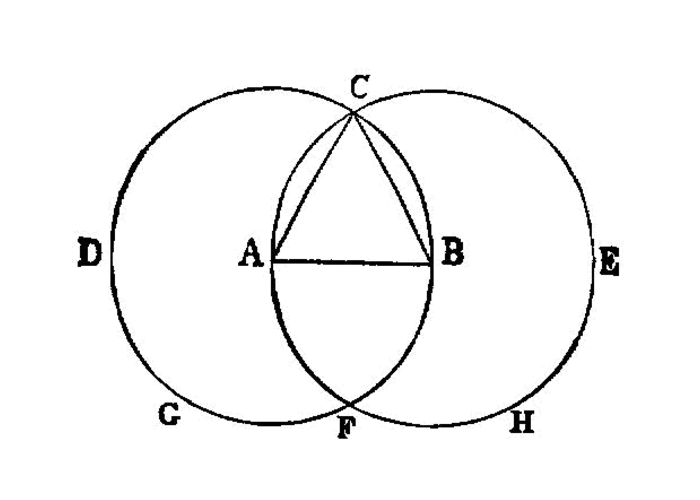Proposition I.1
Construct an Equilateral Triangle on a Segment

On a given finite straight line 1 to construct an equilateral triangle.
Let AB be the given finite straight line.2
Thus it is required to construct an equilateral triangle on the straight line AB.
With centre A and distance AB let the circle BCD be described3; I.post.3 again, with centre B and distance BA let the circle ACE be described; I.post.3 and from the point C4, in which the circles cut one another, to the points A, B let the straight lines CA, CB be joined. I.post.1
Now, since the point A is the centre of the circle CDB,
ACis equal toAB. I.def.15
Again, since the point B is the centre of the circle CAE,
BCis equal toBA. I.def.15
But CA was also proved equal to AB; therefore each of the straight lines CA, CB is equal to AB.
And things which are equal to the same thing are also equal to one another; I.c.n.1
- therefore
CAis also equal toCB.
Therefore the three straight lines CA, AB, BC are equal to one another.5
Therefore the triangle ABC is equilateral; and it has been constructed on the given finite straight line AB.
- (Being) what it was required to do.
References
Footnotes
-
On a given finite straight line
The Greek usage differs from ours in that the definite article is employed in such a phrase as this where we have the indefinite.ἐπὶ τῆς δοθείσης εὐθείας πεπερασμένης ,on the given finite straight line,
i.e. the finite straight line which we choose to take. ↩ -
Let
ABbe the given finite straight line.
To be strictly literal we should have to translate in the reverse orderlet the given finite straight line be the (straight line)
; but this order is inconvenient in other cases where there is more than one datum, e.g. in the setting-out of I. 2,ABlet the given point be
the awkwardness arising from the omission of the verb in the second clause. Hence I have, for clearness' sake, adopted the other order throughout the book. ↩A, and the given straight lineBC, -
let the circle
BCDbe described.
Two things are here to be quoted,- the elegant and practically universal use of the perfect passive imperative in constructions,
γεγράφθω meaning of courselet it have been described
orsuppose it described,
- the impossibility of expressing shortly in a translation the force of the words in their original order.
κύκλος γεγράφθω ὸ ΒΓΔ means literallylet a circle have been described, the (circle, namely, which I dequote by)
Similarly we have lower downBCD.let straight lines, (namely) the (straight lines)
CA,CB, be joined,ἐπεζεύχθωσαν εὐθεῖαι αί ΓΑ, ΓΒ . There seems to be no practicable alternative, in English, but to translate as I have done in the text.
- the elegant and practically universal use of the perfect passive imperative in constructions,
-
from the point
C
Euclid is careful to adhere to the phraseology of Postulate 1 except that he speaks ofjoining
(ἐπεζεύχθωσαν ) instead ofdrawing
(γράφειν ). He does not allow himself to use the shortened expressionlet the straight line
(without mention of the pointsFCbe joinedF,C) until I. 5. ↩ -
each of the straight lines
CA,CB
,ἑκατέρα τῶν ΓΑ, ΓΒ and 24. the three straight linesCA,AB,BC,αἱ τρεῖς αἱ ΓΑ, ΑΒ, ΒΓ . I have, here and in all similar expressions, inserted the wordsstraight lines
which are not in the Greek. The possession of the inflected definite article enables the Greek to omit the words, but this is not possible in English, and it would scarcely be English to writeeach of
orCA,CBthe three
↩CA,AB,BC.
